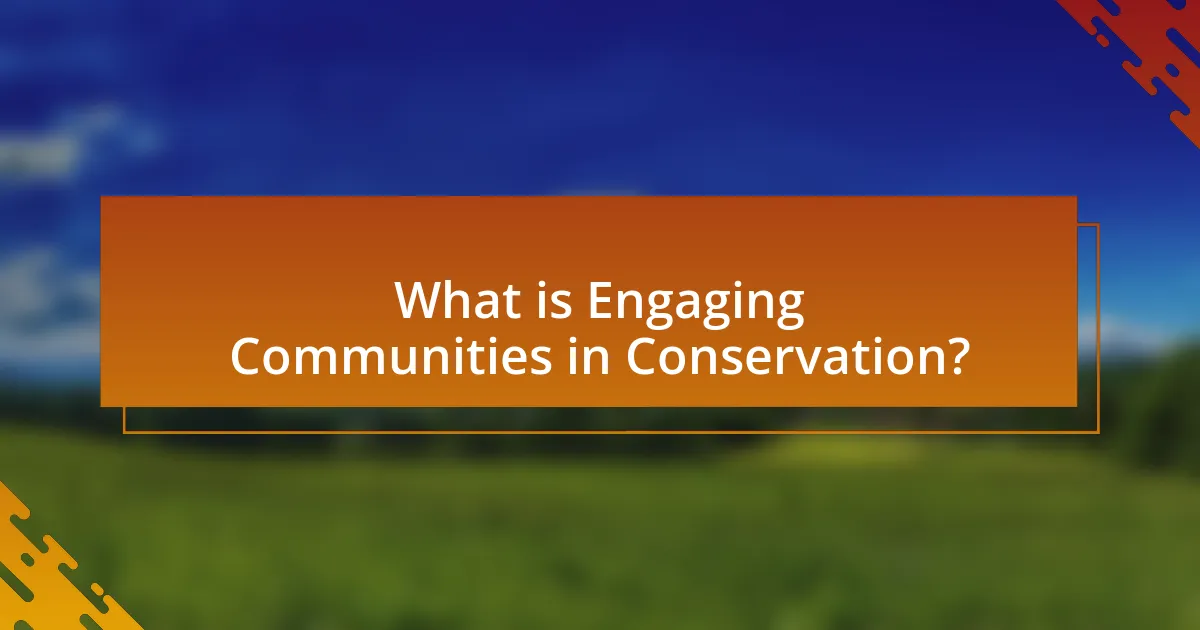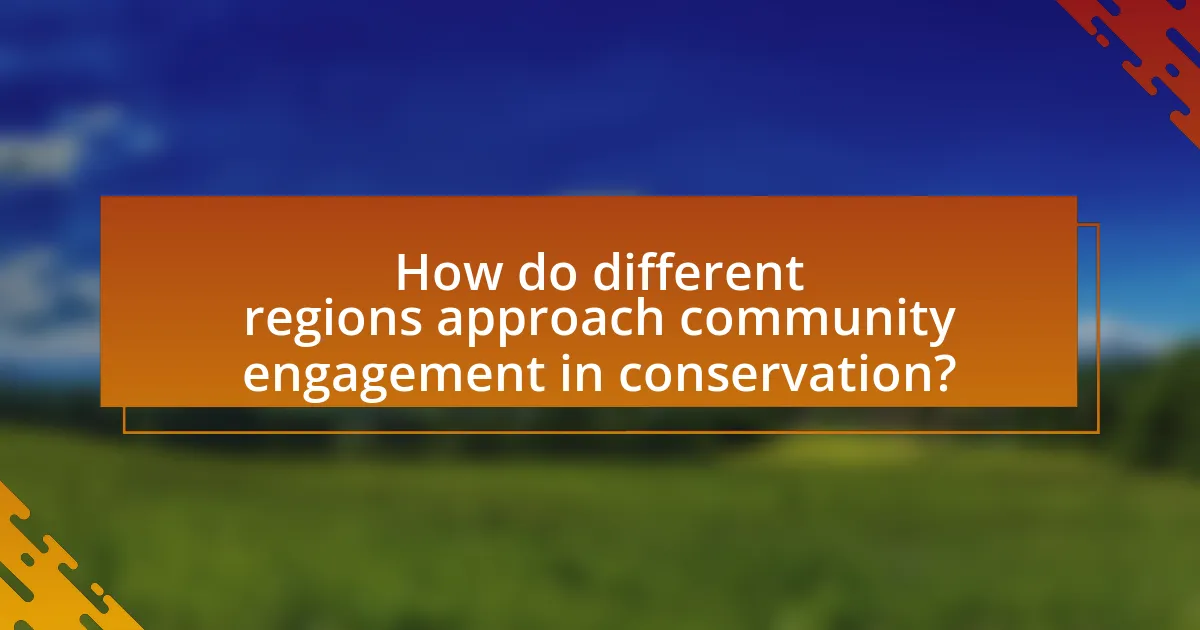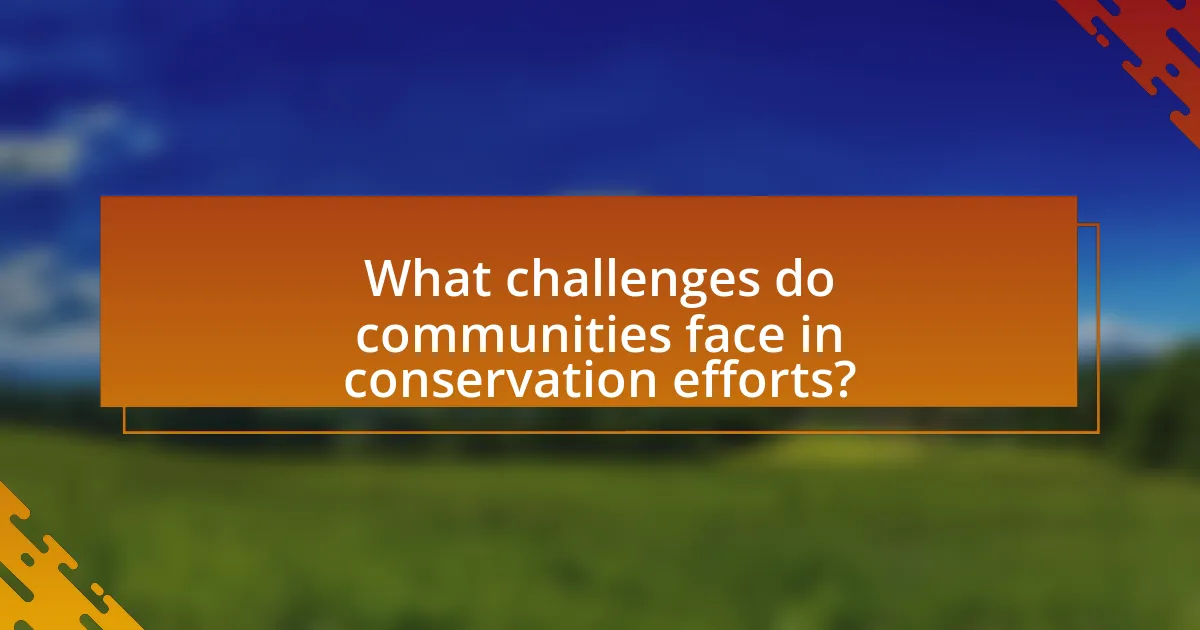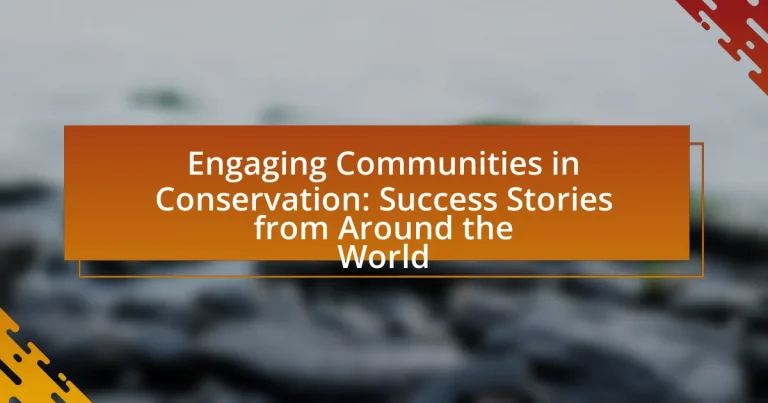Engaging Communities in Conservation emphasizes the importance of local populations’ involvement in protecting and managing natural resources. The article outlines how community engagement fosters local ownership, enhances biodiversity, and leads to sustainable conservation outcomes through participatory decision-making and shared stewardship. It highlights successful case studies from various regions, including Africa and Asia, showcasing strategies such as community-based natural resource management and eco-tourism. Additionally, the article addresses challenges communities face in conservation efforts, such as funding and education, and discusses best practices for effective engagement, including partnerships with NGOs and governments.

What is Engaging Communities in Conservation?
Engaging Communities in Conservation refers to the active involvement of local populations in conservation efforts to protect and manage natural resources. This approach recognizes that communities possess valuable knowledge and a vested interest in their local environments, which can lead to more effective and sustainable conservation outcomes. Evidence shows that when communities are engaged, such as through participatory decision-making and shared stewardship, conservation initiatives are more likely to succeed, as demonstrated by various global case studies highlighting improved biodiversity and ecosystem health.
Why is community engagement important in conservation efforts?
Community engagement is crucial in conservation efforts because it fosters local ownership and stewardship of natural resources. When communities are actively involved, they are more likely to support and sustain conservation initiatives, leading to better environmental outcomes. Research indicates that projects with strong community participation, such as the Community-Based Natural Resource Management in Namibia, have resulted in increased biodiversity and improved livelihoods. Engaging local populations ensures that conservation strategies are culturally relevant and tailored to specific ecological contexts, enhancing their effectiveness and longevity.
How does community involvement enhance conservation outcomes?
Community involvement enhances conservation outcomes by fostering local stewardship and increasing the effectiveness of conservation initiatives. When communities actively participate in conservation efforts, they contribute valuable local knowledge, which can lead to more tailored and effective strategies. For instance, a study published in the journal “Conservation Biology” found that community-managed areas in Madagascar showed higher biodiversity levels compared to those managed solely by external organizations. This demonstrates that local engagement not only improves ecological results but also promotes sustainable practices that align with community needs and values.
What are the key principles of community engagement in conservation?
The key principles of community engagement in conservation include inclusivity, collaboration, empowerment, and sustainability. Inclusivity ensures that all community members, especially marginalized groups, have a voice in conservation efforts, fostering a sense of ownership and responsibility. Collaboration involves partnerships between local communities, conservation organizations, and government entities, which enhances resource sharing and knowledge exchange. Empowerment focuses on building local capacity and skills, enabling communities to take active roles in conservation initiatives. Sustainability emphasizes long-term benefits and practices that support both ecological health and community well-being. These principles are supported by successful case studies, such as the community-led conservation efforts in Madagascar, which demonstrate that engaging local populations leads to more effective and lasting conservation outcomes.
What are some successful examples of community engagement in conservation?
Successful examples of community engagement in conservation include the Maasai Mara Wildlife Conservancies in Kenya, where local communities manage wildlife resources and benefit from eco-tourism, leading to increased wildlife populations and improved livelihoods. Another example is the community-led reforestation efforts in the Philippines, particularly in the town of Ipo Watershed, which resulted in a 50% increase in forest cover over a decade, demonstrating the effectiveness of local stewardship in environmental restoration. Additionally, the Great Bear Rainforest initiative in Canada showcases how Indigenous communities partnered with environmental organizations to protect vast tracts of forest, resulting in a landmark conservation agreement that balances ecological preservation with community rights. These cases illustrate the power of local involvement in achieving conservation goals.
How have local communities contributed to wildlife protection?
Local communities have significantly contributed to wildlife protection through initiatives such as community-based conservation programs and sustainable resource management practices. These programs empower local populations to take an active role in protecting their natural environments, often leading to increased biodiversity and habitat preservation. For instance, in Namibia, community conservancies have resulted in a 50% increase in wildlife populations since their establishment, demonstrating the effectiveness of local stewardship in conservation efforts. Additionally, local communities often engage in anti-poaching activities and habitat restoration, further enhancing their role in wildlife protection.
What role do indigenous practices play in conservation success stories?
Indigenous practices play a crucial role in conservation success stories by integrating traditional ecological knowledge with sustainable resource management. These practices often include methods of land stewardship, biodiversity conservation, and sustainable harvesting that have been refined over generations. For instance, the use of controlled burns by Indigenous Australians has been shown to reduce wildfire risks and promote biodiversity, as documented in studies by the Australian government. Additionally, the participation of Indigenous communities in the management of protected areas, such as the co-management of national parks in Canada, has led to improved conservation outcomes and enhanced ecosystem health. This synergy between traditional knowledge and modern conservation strategies demonstrates the effectiveness of Indigenous practices in achieving successful conservation results.

How do different regions approach community engagement in conservation?
Different regions approach community engagement in conservation through tailored strategies that reflect local cultures, needs, and environmental challenges. For instance, in Africa, community-based natural resource management programs empower local populations to manage wildlife and forests, leading to increased biodiversity and economic benefits, as evidenced by the success of Namibia’s communal conservancies, which have resulted in a significant rise in wildlife populations and local income. In contrast, in North America, collaborative governance models involving partnerships between government agencies, Indigenous groups, and local communities focus on shared decision-making and stewardship, exemplified by the Great Bear Rainforest agreement in Canada, which protects vast areas of forest while respecting Indigenous rights. These region-specific approaches demonstrate that effective community engagement in conservation hinges on understanding and integrating local contexts and values.
What strategies are used in Africa for community conservation?
Community conservation in Africa employs several strategies, including community-based natural resource management (CBNRM), ecotourism, and participatory governance. CBNRM empowers local communities to manage their natural resources sustainably, leading to improved biodiversity and livelihoods. For instance, in Namibia, CBNRM has resulted in increased populations of wildlife and enhanced community income through sustainable hunting and tourism. Ecotourism initiatives, such as those in Kenya, provide financial incentives for communities to protect their ecosystems while generating revenue from visitors. Participatory governance involves local communities in decision-making processes regarding conservation efforts, fostering a sense of ownership and responsibility. These strategies collectively demonstrate effective approaches to conservation that benefit both the environment and local populations.
How do community-based tourism initiatives support conservation in Africa?
Community-based tourism initiatives support conservation in Africa by empowering local communities to manage and benefit from their natural resources. These initiatives create economic incentives for conservation, as communities receive financial rewards from tourism activities that promote the protection of wildlife and habitats. For example, in Namibia, community conservancies have led to a significant increase in wildlife populations and habitat preservation, with over 40% of the country’s land now managed by local communities. This model not only fosters sustainable practices but also enhances community engagement in conservation efforts, ensuring that local populations have a vested interest in maintaining biodiversity and ecosystem health.
What lessons can be learned from African community conservation projects?
African community conservation projects demonstrate the importance of local involvement in sustainable resource management. These projects reveal that when communities are actively engaged, they are more likely to protect their natural resources, as seen in the case of the Maasai Mara Wildlife Conservancies in Kenya, where local stewardship has led to increased wildlife populations and improved livelihoods. Furthermore, these initiatives highlight the effectiveness of integrating traditional ecological knowledge with modern conservation practices, which enhances biodiversity and ecosystem resilience. Evidence from the African Wildlife Foundation indicates that community-led conservation efforts can reduce poaching rates by up to 50%, showcasing the tangible benefits of empowering local populations in conservation strategies.
What are the unique approaches taken in Asia for engaging communities?
Unique approaches taken in Asia for engaging communities include participatory conservation initiatives, where local populations are actively involved in decision-making processes regarding natural resource management. For instance, in India, the Joint Forest Management program empowers local communities to manage forest resources sustainably, resulting in increased biodiversity and improved livelihoods. Additionally, in Japan, community-based disaster risk reduction strategies engage residents in preparedness and response planning, enhancing resilience to natural disasters. These methods demonstrate a commitment to integrating local knowledge and fostering collaboration, which has proven effective in achieving conservation goals while benefiting community welfare.
How do cultural values influence conservation efforts in Asia?
Cultural values significantly influence conservation efforts in Asia by shaping community attitudes towards environmental stewardship and resource management. For instance, in many Asian cultures, traditional beliefs emphasize harmony with nature, which fosters a collective responsibility to protect local ecosystems. This is evident in practices such as the sacred groves in India, where communities preserve forests due to their spiritual significance, thereby contributing to biodiversity conservation. Additionally, cultural narratives and folklore often highlight the importance of specific species, motivating communities to engage in conservation initiatives. Research shows that integrating local cultural values into conservation strategies enhances community participation and effectiveness, as seen in projects across countries like Indonesia and the Philippines, where local customs are aligned with conservation goals.
What successful case studies exist in Asian community conservation?
Successful case studies in Asian community conservation include the community-based forest management in the Philippines, where local communities manage forest resources, leading to a 20% increase in forest cover over a decade. Another example is the conservation of the snow leopard in Mongolia, where local herders participate in conservation efforts, resulting in a 30% increase in the snow leopard population since 2008. Additionally, the community-led marine conservation in Indonesia has led to the establishment of marine protected areas, which have shown a 50% increase in fish biomass within five years. These cases demonstrate effective community engagement in conservation efforts across Asia, yielding significant ecological benefits.

What challenges do communities face in conservation efforts?
Communities face several challenges in conservation efforts, including lack of funding, insufficient education and awareness, and conflicting interests among stakeholders. Lack of funding limits the resources available for conservation projects, making it difficult to implement and sustain initiatives. Insufficient education and awareness can lead to a lack of community engagement and support for conservation efforts, as individuals may not understand the importance of preserving local ecosystems. Additionally, conflicting interests among stakeholders, such as economic development versus environmental protection, can create tensions that hinder collaborative conservation efforts. These challenges are documented in various studies, including the “State of the World’s Forests” report by the Food and Agriculture Organization, which highlights the need for integrated approaches to address these issues effectively.
What barriers hinder effective community engagement in conservation?
Barriers that hinder effective community engagement in conservation include lack of trust, insufficient resources, and inadequate communication. Lack of trust arises when communities feel excluded from decision-making processes, leading to skepticism about conservation initiatives. Insufficient resources, such as funding and training, limit the ability of communities to participate actively in conservation efforts. Inadequate communication often results in misunderstandings about conservation goals and practices, further alienating community members. Research indicates that these barriers can significantly reduce the effectiveness of conservation programs, as evidenced by case studies where community involvement was minimal due to these issues.
How do socio-economic factors impact community participation?
Socio-economic factors significantly impact community participation by influencing individuals’ access to resources, education, and social networks. Communities with higher income levels and educational attainment tend to have greater participation rates in local initiatives, as these factors provide individuals with the skills and confidence needed to engage effectively. For instance, a study published in the Journal of Community Development found that communities with higher socio-economic status had 30% more participation in conservation projects compared to lower-income areas, highlighting the correlation between economic stability and active involvement in community affairs.
What role does education play in overcoming these challenges?
Education plays a crucial role in overcoming challenges related to community engagement in conservation efforts. By providing knowledge about environmental issues, sustainable practices, and the importance of biodiversity, education empowers individuals and communities to take informed actions. For instance, programs that educate local populations about the ecological impact of their activities have been shown to reduce deforestation rates by up to 30% in certain regions, as evidenced by initiatives in Brazil’s Amazon rainforest. Furthermore, education fosters a sense of stewardship and responsibility towards natural resources, leading to increased participation in conservation projects and improved outcomes for both the environment and local communities.
How can communities overcome these challenges to enhance conservation?
Communities can overcome challenges to enhance conservation by fostering collaboration among local stakeholders, implementing education programs, and utilizing sustainable practices. Collaborative efforts, such as forming partnerships with NGOs and government agencies, enable resource sharing and collective problem-solving, which has been shown to improve conservation outcomes. For instance, the community-led conservation initiatives in Namibia have successfully reduced poaching and increased wildlife populations through shared responsibility and local governance. Education programs raise awareness about the importance of biodiversity and sustainable practices, empowering community members to take action. Additionally, adopting sustainable agricultural and fishing practices can mitigate environmental degradation, as evidenced by the success of community-managed marine areas in the Philippines, which have led to increased fish stocks and healthier ecosystems.
What best practices can be implemented for effective community engagement?
Effective community engagement can be achieved through practices such as fostering open communication, building trust, and involving community members in decision-making processes. Open communication ensures that community members are informed and feel heard, which is crucial for participation. Building trust involves consistent and transparent interactions, allowing communities to feel secure in their relationships with organizations. Involving community members in decision-making empowers them and enhances ownership of conservation initiatives. Research indicates that projects with high community involvement, such as the “Community-Based Natural Resource Management” in Namibia, have led to improved conservation outcomes and increased local support for initiatives.
How can partnerships with NGOs and governments support community efforts?
Partnerships with NGOs and governments can significantly enhance community efforts by providing resources, expertise, and legitimacy. These collaborations often lead to increased funding opportunities, as NGOs typically have access to grants and donations, while governments can allocate public funds for community projects. For instance, the collaboration between the World Wildlife Fund and local governments in various countries has resulted in successful conservation initiatives that empower local communities through training and capacity building. Additionally, such partnerships can facilitate knowledge sharing, enabling communities to adopt best practices in conservation and sustainable development, as evidenced by the success of the Integrated Coastal Zone Management project in the Philippines, which involved local governments and NGOs working together to improve coastal resource management.
What practical steps can communities take to engage in conservation?
Communities can engage in conservation by implementing local initiatives such as organizing clean-up drives, establishing community gardens, and creating awareness programs about biodiversity. For instance, clean-up drives can significantly reduce pollution in local habitats, while community gardens promote native plant growth and provide habitats for local wildlife. Awareness programs can educate residents on the importance of conservation, leading to increased community involvement. According to a study published in the Journal of Environmental Management, community-led conservation efforts have shown a 30% increase in local biodiversity when residents actively participate in conservation activities.
How can communities develop their own conservation initiatives?
Communities can develop their own conservation initiatives by assessing local environmental needs, engaging stakeholders, and creating actionable plans. First, communities should conduct assessments to identify specific conservation challenges, such as habitat loss or pollution, which can be supported by local environmental data. Next, engaging stakeholders, including local residents, businesses, and government entities, fosters collaboration and ensures diverse perspectives are included. For instance, the community-led conservation efforts in Costa Rica have successfully involved local farmers in reforestation projects, demonstrating the effectiveness of stakeholder engagement. Finally, communities should create and implement actionable plans that outline specific goals, strategies, and timelines, which can be informed by successful models from other regions, such as the community-based marine conservation initiatives in the Philippines that have led to increased fish populations and biodiversity.
What resources are available for communities looking to engage in conservation?
Communities looking to engage in conservation can access various resources, including funding opportunities, educational programs, and partnerships with environmental organizations. Funding sources such as grants from the National Fish and Wildlife Foundation and the Environmental Protection Agency support local conservation projects. Educational programs offered by organizations like the Nature Conservancy provide training and resources for community members to understand conservation practices. Additionally, partnerships with local NGOs and government agencies can facilitate access to expertise and tools necessary for effective conservation efforts. These resources collectively empower communities to implement sustainable practices and protect their natural environments.


